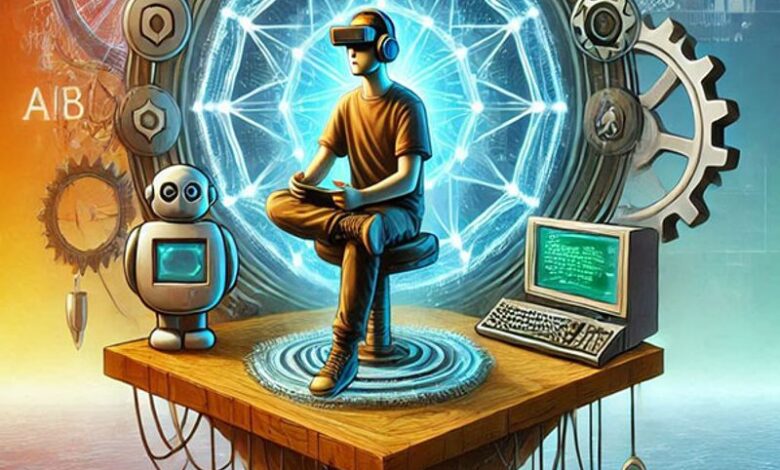Summary: Virtual Reality, Blockchain, and Artificial Intelligence: Navigating Game Development Technologies

VMPL
New Delhi [India]January 7: Game development is evolving at an incredible speed with the integration of emerging technologies such as virtual reality (VR), artificial intelligence (AI), and blockchain technology. By enabling unprecedented levels of interactivity, asset ownership and community management, these innovations are changing not only how games are designed and played, but also how they are monetized, providing developers with such tremendous creative opportunities to build truly immersive, engaging and safe gaming experiences. With this huge potential, it becomes important to… Game developers in India and around the world to learn how they can leverage these technologies and integrate them into their projects, in order to remain competitive in a highly competitive market.
What VR has taught us about immersive storytelling
Gaming has become closely associated with next-level immersion thanks to virtual reality. By placing players in fully realized 3D environments, VR allows developers to create experiences that go beyond traditional narratives. Whether you’re navigating the ruins of a lost civilization or grappling with the struggles of a zombie apocalypse, virtual reality offers an unparalleled sense of presence and engagement.
Developers consider Virtual reality game developmentThe first step is to understand its ability to enhance a project’s narrative. To deliver immersive storytelling, you need not only advanced visual fidelity, but also real, meaningful interaction. Your choice of hardware — whether it’s Oculus or PlayStation VR, or a standalone VR headset like the Meta Quest — will make a big difference in the way you scale, and ultimately in the user experience. Motion sickness is a constant problem in VR, as is real-time rendering at high frame rates.
As with any other medium, the audience must be kept in mind to understand whether VR is the right choice for a particular project, so we must first analyze who the intended viewer is. Are they tech-savvy gamers waiting for something new? Do they gravitate toward genres, such as horror, adventure, or simulation, that are better suited to immersive environments? It will allow developers to determine if VR is truly the way to deliver their vision based on their audience’s preferences.
Leverage AI for dynamic and personalized gameplay
Artificial Intelligence has revolutionized creative video game development, making it possible to provide more dynamic, responsive and personalized gameplay. From NPCs that mimic human behaviors to adaptive difficulty settings that adjust as the player progresses, AI adds layers of depth and realism to games that were previously unattainable.
Since AI is so versatile, it can be used for many purposes in game development. Take procedural content generation, for example: you can build the genomes of huge, complex worlds with very little manual tuning. Additionally, AI-powered analytics can provide instant feedback on player behavior, which can further improve gameplay and boost retention rates.
For developers and blockchain game development companies who want to implement AI, the best way is to ensure that their games are functional even if they are innovative. While cutting-edge AI systems, such as deep learning, can unleash some remarkable capabilities — such as images being mostly free-form — they also require a great deal of computation and expertise. Whether this complexity fits the project size and budget depends on the developers.
Audience evaluation is equally important. Meanwhile, for casual gamers, AI that improves ease of use and accessibility such as intelligent tutorials or adaptive controls may be more attractive. In contrast, experienced players may want high-level AI enemies that provide an additional challenge. Developers need to align what AI can deliver with what audiences expect from their games in order to stand out in a crowded market.
Investigating Blockchain for secure and transparent transactions
November 3, 2023295Blockchain Tech Are you also wondering how to use Blockchain technology in games? For developers seeking to seize this emerging trend, blockchain technology offers possibilities to revolutionize gameplay and monetization.
The development of non-fungible tokens (NFTs) is probably one of the most exciting use cases for blockchain technology in the gaming industry. It allows players to own unique items in their gaming experience, for example, skins, weapons or characters, which can be seamlessly traded or sold between platforms. This not only improves player engagement, but also creates new revenue opportunities for developers.
However, the path to blockchain technology integration is not smooth. Developers must navigate important factors such as scalability, transaction fees, and regulatory concerns. Work with experienced people Blockchain game development Businesses can further reduce these risks, allowing the technology to be implemented safely and effectively.
Developers considering using blockchain will want to evaluate whether their audience finds value in transparency and ownership. For example, games designed for younger players and casual gamers may not need blockchain elements, while savvy crypto users may appreciate the additional perks it offers. By matching blockchain integration to your audience, it will dramatically increase its application and importance.
How to choose the right technology for your project
When choosing the right technology for a game development project, the process must be balanced between creativity, practicality, and audience alignment. Virtual reality, artificial intelligence, and blockchain each have their pros and cons; Their effective integration is key.
When it comes to projects that revolve around immersive storytelling, virtual reality is the natural destination. But it requires a significant investment in hardware, software, and talent. It is up to developers to ensure that the scope of the project ensures these costs and that the target audience will accept the VR content.
AI is ideal for improving player engagement across multiple genres due to its ability to customize and adapt playstyles. But its application has to be purposeful, whether that’s NPC behavior, game balance, or player analysis. AI developers must also address ethical concerns surrounding AI such as data privacy and algorithmic bias to ensure the technology is used responsibly.
Blockchain use cases related to gaming are still relatively nascent, but offer a lot of potential for enabling decentralized economies and secure transactions. The adoption of such a transformative technology must be based on a comprehensive appreciation of audience demands and market trends, coupled with a robust approach to overcoming technical and regulatory challenges.
Evaluate alignment with client goals and audience needs
As with other new technologies, a lot of work must go into ensuring that the new shiny thing fits the client’s goals and audience desire. Developers should start with a series of important questions:
What do you hope to achieve most of all? Will it be a highly immersive experience, a competitive multiplayer game, or an innovative monetization model?
Who is the target audience? Who are the players, their playing styles and technological readiness?
How is the project budgeted and scheduled? Is it possible to use the chosen technology within these constraints without losing quality?
We get great answers to these questions through market research and user testing. They can also work closely with clients to develop their vision and ensure that the technology used does not complicate the project, but enables it.
The future of game development: what comes next?
Virtual reality, artificial intelligence, and blockchain will become mainstream as the industry evolves. The emergence of these technologies is a challenge but also an opportunity for Indian game developers to innovate and compete on the global stage. Expert Column By Karan Bhardwaj Karan Bhardwaj is a game developer at Polymers Studios.
Developers who keep up with new trends, invest in upskilling, and focus on audience alignment can leverage the full potential of these technologies. The future of game development lies in the seamless merging of creativity and technology, whether through crafting stunning VR experiences, designing AI-driven games, or building blockchain economies.
By taking steps like this, we can not only help our individual projects in the market, but also help the gaming industry expand and mature over time. The possibilities are endless for developers wanting to embrace these innovations, and this is just the beginning of the journey.
(Advertising Disclaimer: The above press release has been provided by VMPL. ANI will not be responsible in any way for its content)
(The story has come from a syndicated feed and has not been edited by Tribune staff.)
https://www.tribuneindia.com/sortd-service/imaginary/v22-01/jpg/large/high?url=dGhldHJpYnVuZS1zb3J0ZC1wcm8tcHJvZC1zb3J0ZC9tZWRpYTI2ZWVkMWEwLWNjYmYtMTFlZi1iZGRkLTU3OWU0N2NiZGZiOC5qcGc=

